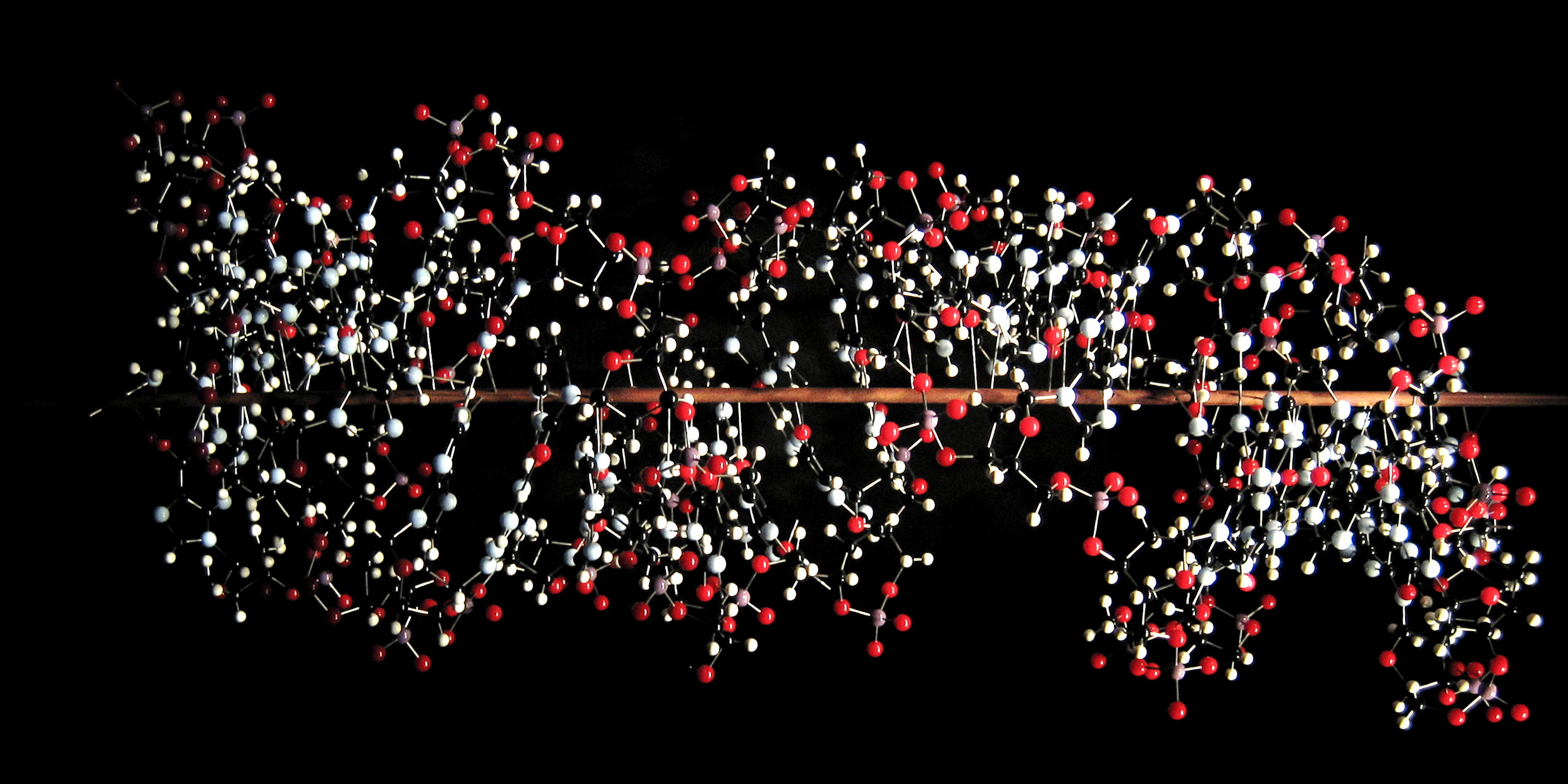Originally published 5 January 1998
Tucked away among the exhibits of Boston’s Museum of Science is a ten-foot-high model of a segment of DNA. The atoms are represented by colored balls — carbon black, oxygen red, nitrogen blue, hydrogen white — linked by rods. It is a Tinker Toy construction without compare.
To my mind, the model is the most extraordinary exhibit in the museum. Whenever I visit, I stand in front of this partial strand of DNA, gape-jawed at the beauty, at the simplicity — out of which emerges the astonishing diversity and awesome complexity of life.
This is the famous double helix, a molecule shaped like a spiral staircase. The side rails of the staircase are linked sugar and phosphate molecules. The steps are paired organic bases: adenine, thymine, guanine, and cytosine, usually labeled A, T, G, and C. The bases appear in four combinations — A‑T, T‑A, C‑G, or G‑C — no more, no less.
The story of life is written in a language of just 4 letters!
The museum’s DNA model contains only a few dozen base pairs, a tiny fraction of what is contained within the DNA of even the simplest living organism. If the whole of a human’s DNA were shown at the scale of the model, it wouldn’t fit within the entire museum.
Nevertheless, what I feel as I stand before the partial model cannot be adequately put into words. Call it reverence, awe, praise. “Euclid alone has looked on Beauty bare,” wrote the poet Edna St. Vincent Millay. Here, in this exquisite geometrical molecule, we look on Beauty bare.
I felt the same response recently when I looked at a schematic map of the complete genome (genetic material) of the bacterium Bacillus subtilis in the journal Nature.
This organism is about as simple as you can get and still be alive — a single chromosome in a microscopic blob of protoplasm. But it moves, it feeds, it metabolizes nutrients from the environment, it reproduces by producing a spore; in short, it does pretty much the same things we spend much of our time doing, although with considerably less introspection and anxiety.
Bacillus subtilis is one of a half-dozen or so organisms whose DNA has been completely sequenced; that is, the entire sequence of base pairs has been determined, along with their genetic functions.
This information is represented in the Nature article as an 8‑page-wide, 15-row-high foldout map of the DNA, with the location of each of more than 4,000 genes shown in vivid color. A complete listing of the more than 4 million base pairs — that long string of As, Ts, Cs, and Gs — is too voluminous to be included in the article; it is stored in computer data bases that are available to scientists.
The function of each of the bacterium’s genes is listed on the back of the gene map. It is a catalog of protein-building mostly — everything required for the life of Bacillus subtilis, from the transport of nutrients across the cell wall, to the production and release of the spore that will ensure the next generation.
A similar map of the human genome would be a 6,000-page-wide foldout. A printed record of all 3 billion base pairs in human DNA would fill more than a dozen sets of the Encyclopedia Britannica.
A complete gene map and base-pair sequence of human DNA will be available early in the 21st century. This information will have countless scientific uses, from helping to reconstruct the history of life to aiding in the design of drugs that will extend life.
But the value of the information is more than scientific. A map of the human DNA can touch us esthetically and spiritually, in the same way that Michelangelo’s David serves as a defining image of the human organism.
Of course, a gene map on the printed page, like Michelangelo’s statue, is static, and only hints at the wonderful dynamism of the DNA molecule as it winds and unwinds, spinning off RNA and proteins, expressing genes as they are needed by the living organism, as if under the direction of an invisible conductor — the magnificent and miraculous symphony of life.
Miraculous? The British writer and cartographer Tim Robinson says in one of his books that miracles are explainable; it is the explanations that are miraculous. The miracle of gene expression by DNA is explainable, and the new gene maps of completely sequenced organisms are a big part of the explanation. But that the essence of life should be so simple — a four-letter code on a spiral staircase — is profoundly miraculous.
The more we learn about the chemistry of life the more miraculous it seems, not in the sense of an arbitrary violation of the laws of nature, but in the rich potentialities of matter itself.
I was looking at the gene map for Bacillus subtilis in the college library, with the 8‑page foldout spread across a table. Several students stopped to look over my shoulder, curious as to what the colorful chart might be.
“This is the blueprint for making a living organism,” I said. I started to provide a more complete explanation, but fell silent. The map spoke for itself. Elegant. Simple. Unfathomably profound.
Beauty bare.



